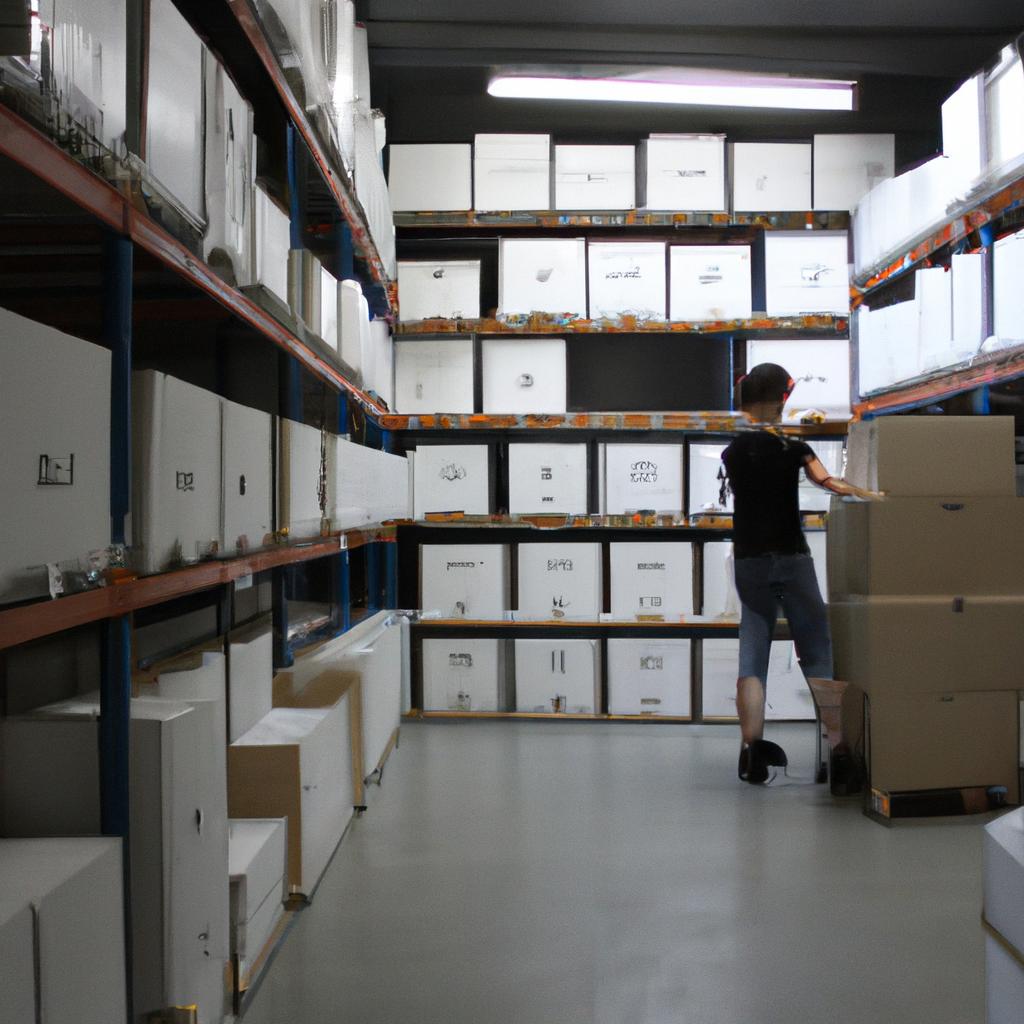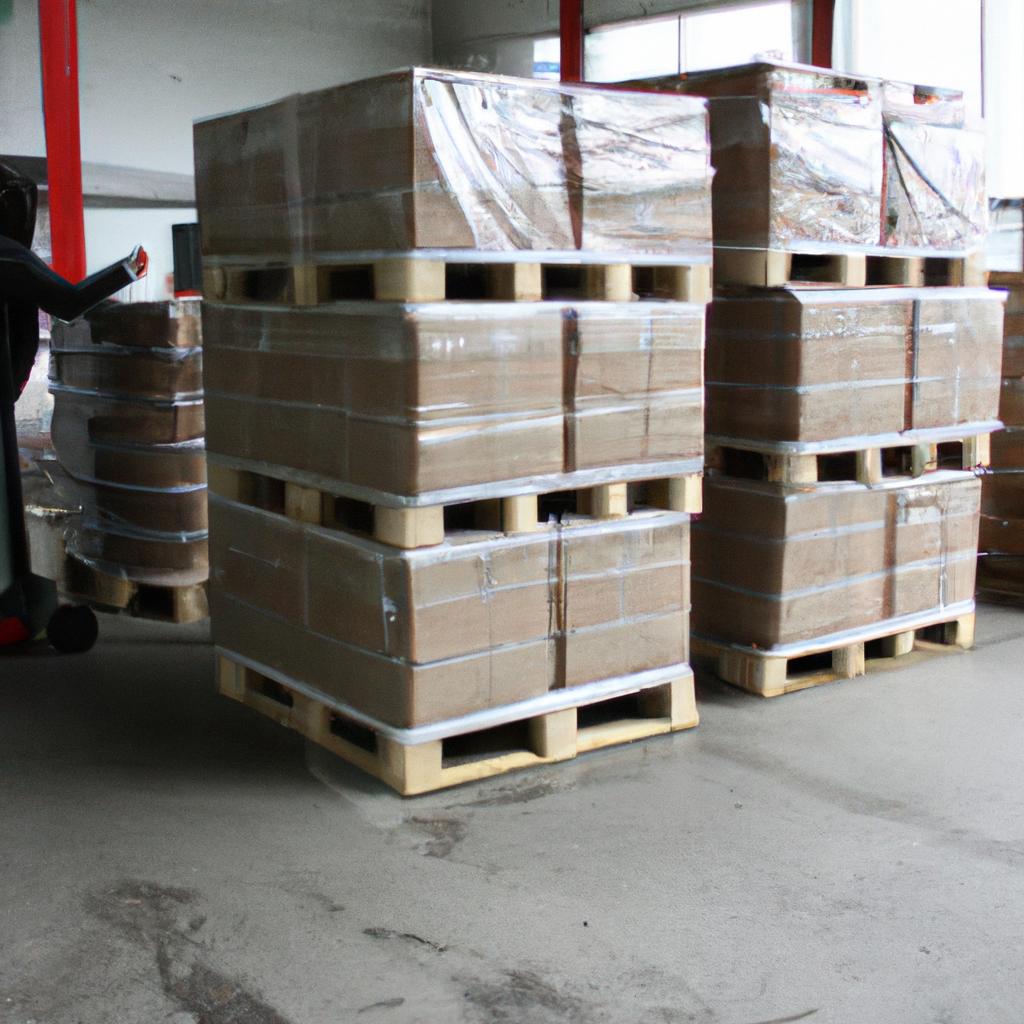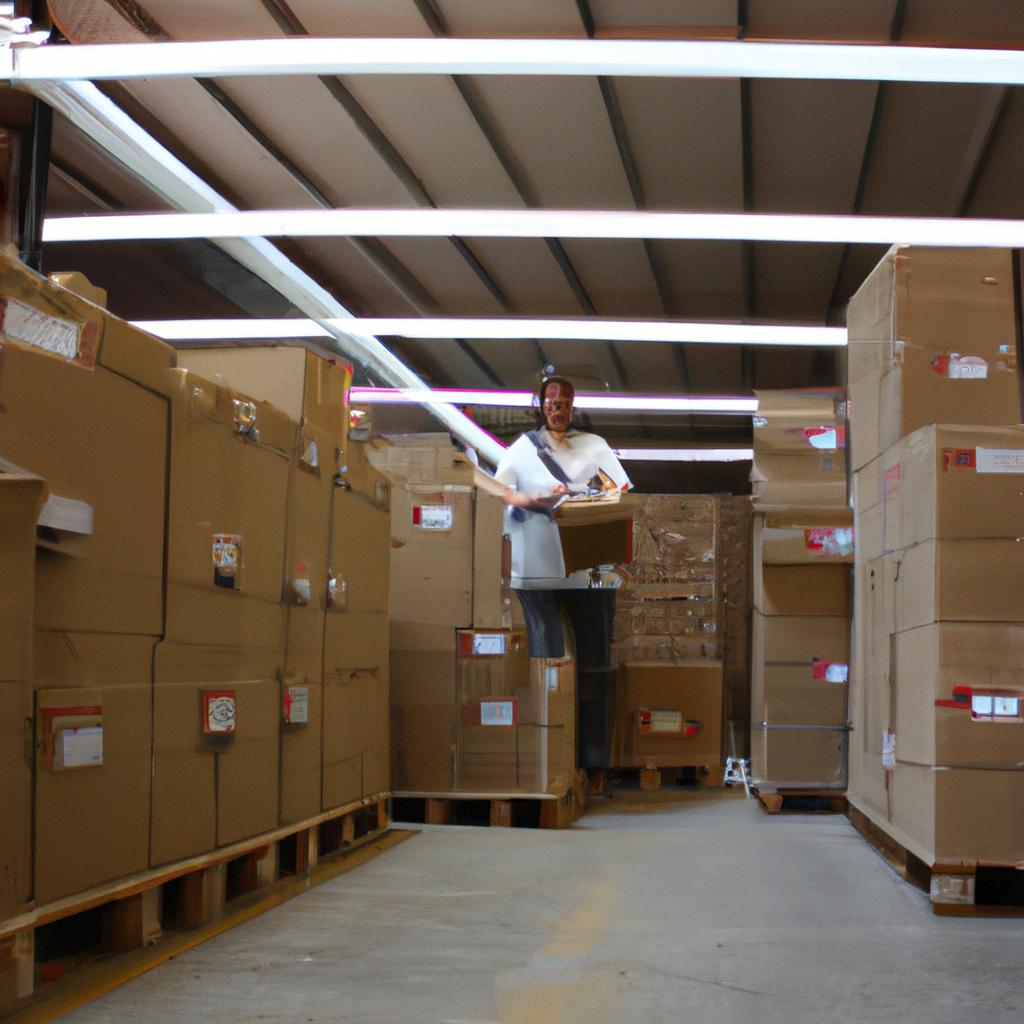In today’s fast-paced and interconnected world, transportation and logistics play a pivotal role in the efficient movement of goods across various supply chains. The ability to track orders accurately has become increasingly vital for businesses to optimize their inventory management processes. For instance, imagine a multinational corporation that imports raw materials from different countries to manufacture its products. Without an effective order tracking system in place, this company may face challenges such as delays in production due to inventory shortages or excess stockpiling resulting in increased carrying costs.
Order tracking systems offer significant benefits for businesses operating in the transportation and logistics sector. By providing real-time visibility into the status of orders, these systems enable companies to streamline their operations by optimizing inventory management effectively. This allows them to keep track of incoming shipments, monitor stock levels at warehouses, and anticipate any potential disruptions along the supply chain. Furthermore, accurate order tracking facilitates timely decision-making regarding reordering, restocking, or adjusting delivery schedules based on demand fluctuations – ultimately leading to improved customer satisfaction and reduced costs associated with overstocking or understocking.
Benefits of Order Tracking in Transportation and Logistics
Order tracking systems play a crucial role in the optimization of inventory management within transportation and logistics. By providing real-time visibility into the movement and status of orders, these systems enable organizations to streamline their operations, enhance customer satisfaction, minimize costs, and improve overall efficiency.
For instance, consider a hypothetical scenario where a global e-commerce company experiences challenges with order fulfillment due to lack of visibility into its supply chain. With an order tracking system in place, the company can track each order from the moment it is placed until it reaches the customer’s doorstep. This level of transparency allows them to proactively address any delays or issues that may arise during transit, ensuring timely deliveries and reducing instances of lost or damaged shipments.
The benefits of implementing order tracking systems are manifold:
- Increased operational efficiency: By accurately tracking orders throughout the entire process, logistics providers can optimize routing and scheduling decisions. This leads to improved resource utilization, reduced idle time for vehicles, and enhanced productivity.
- Enhanced customer satisfaction: Real-time order tracking empowers customers by keeping them informed about the progress of their shipments. This not only reduces anxiety but also enables proactive communication regarding potential delays or changes in delivery schedules.
- Minimized inventory holding costs: Improved visibility into order statuses allows organizations to better manage stock levels. By avoiding overstocking or understocking situations through accurate demand forecasting enabled by order tracking systems, companies can reduce carrying costs associated with excess inventory.
- Mitigated risks and increased security: Order tracking systems provide valuable insights into shipment locations at any given time. This helps identify potential bottlenecks or vulnerabilities in the supply chain, allowing businesses to implement appropriate risk mitigation strategies.
| Benefit | Description |
|---|---|
| Operational Efficiency | Accurate tracking facilitates optimal routing and scheduling decisions leading to improved resource utilization and increased productivity. |
| Customer Satisfaction | Real-time updates on order statuses enable proactive communication with customers, reducing anxiety and enhancing overall satisfaction. |
| Cost Reduction | Better inventory management through accurate demand forecasting helps minimize holding costs associated with excess stock. |
| Risk Mitigation | The ability to track shipments in real-time enables timely identification of vulnerabilities and implementation of appropriate risk mitigation measures. |
In summary, order tracking systems provide numerous benefits for transportation and logistics operations. By improving operational efficiency, enhancing customer satisfaction, minimizing inventory holding costs, and mitigating risks, these systems contribute to the overall success of supply chain management.
Furthermore, organizations must be aware of the challenges they might encounter during the implementation process of order tracking systems.
Challenges of Implementing Order Tracking Systems
In the previous section, we discussed the benefits of implementing order tracking systems in transportation and logistics. Now, let’s delve into some of the challenges that organizations may face when adopting these systems.
Implementing order tracking systems can be a complex process, requiring careful planning and consideration. One major challenge is the initial investment required to set up such a system. Companies must invest in hardware, software, and training for employees to effectively utilize the new technology. Additionally, integrating the order tracking system with existing inventory management systems can pose technical difficulties and require customized solutions.
Another challenge lies in ensuring data accuracy and consistency across different stages of transportation and logistics operations. For example, consider a hypothetical scenario where an online retailer uses an order tracking system to monitor its supply chain from warehouse to final delivery. In this case, if there are discrepancies between recorded inventory levels at various stages or inaccurate information about transit times, it can lead to delays or even customer dissatisfaction.
Moreover, maintaining effective communication among stakeholders is crucial for successful implementation of order tracking systems. Different parties involved in transportation and logistics operations – suppliers, carriers, warehouses – need to collaborate seamlessly through real-time updates on shipment status and other relevant information. Failure to establish clear lines of communication can result in miscommunication or missed opportunities for optimization.
To emphasize the significance of addressing these challenges proactively, consider the following emotional bullet points:
- Increased operational efficiency: Streamlining processes with order tracking reduces errors and delays.
- Enhanced customer satisfaction: Real-time visibility empowers customers by providing accurate estimated arrival times.
- Improved resource allocation: Optimized routing based on live data ensures better utilization of vehicles and fuel consumption.
- Mitigated risks: Identifying potential bottlenecks early allows companies to take preventive measures before they become critical issues.
Furthermore, we present a table illustrating how different stakeholders benefit from implementing an order tracking system:
| Stakeholder | Benefit | Example |
|---|---|---|
| Customers | Enhanced visibility and accountability | Tracking their order from placement to delivery |
| Suppliers | Improved supply chain planning | Real-time data on demand trends for better inventory management |
| Carriers | Efficient fleet utilization | Optimized routes based on real-time traffic information |
| Warehouses | Streamlined operations | Accurate inventory tracking for effective stock control |
In conclusion, while implementing order tracking systems in transportation and logistics comes with its own set of challenges, the benefits far outweigh the difficulties. By addressing these challenges through careful planning, investment, and effective communication, organizations can optimize their inventory management processes and enhance overall operational efficiency.
Transitioning into the subsequent section about “Key Features to Look for in an Order Tracking Solution,” it is essential to consider specific aspects that can help organizations choose the most suitable system for their needs.
Key Features to Look for in an Order Tracking Solution
Implementing order tracking systems in the transportation and logistics industry can be a complex task, as it involves overcoming several challenges. One significant challenge is the integration of multiple data sources from various stakeholders involved in the supply chain process. For instance, consider a scenario where an e-commerce company collaborates with multiple carriers for delivering their products to customers. Integrating real-time tracking information from these carriers into a single system requires seamless communication and data exchange protocols.
Another challenge lies in ensuring data accuracy and consistency throughout the entire order fulfillment process. Inaccurate or inconsistent data can lead to miscommunication between different parties involved, resulting in delays or errors in inventory management. For example, if there are discrepancies between the recorded inventory levels and actual stock availability due to inaccurate tracking information, it may result in overstocking or stockouts, leading to financial losses.
Furthermore, maintaining cybersecurity and protecting sensitive customer information is crucial when implementing order tracking systems. With increasing concerns about data breaches and cyber threats, companies need robust security measures to safeguard their systems and prevent unauthorized access to valuable shipment data. Failure to address cybersecurity risks adequately can not only compromise customer trust but also expose businesses to legal liabilities.
To better understand the challenges faced during implementation, here are some key points:
- Integration of diverse data sources: Coordinating real-time tracking information from multiple carriers and suppliers.
- Ensuring accurate data: Avoiding discrepancies between recorded inventory levels and actual stock availability.
- Cybersecurity: Protecting sensitive customer information by implementing strong security measures.
Table: Challenges of Implementing Order Tracking Systems
| Challenge | Description |
|---|---|
| Integration of diverse data sources | Requires seamless communication among various stakeholders involved in the supply chain process |
| Ensuring accurate data | Prevents miscommunication between parties regarding inventory levels |
| Cybersecurity | Protects valuable shipment data from unauthorized access and potential cyber threats |
In the upcoming section, we will explore the importance of real-time visibility in order tracking systems and how it can address some of these challenges. By emphasizing the significance of real-time information in optimizing inventory management, businesses can better understand its role in streamlining operations and improving customer satisfaction.
Importance of Real-Time Visibility in Order Tracking
Real-time visibility is a critical aspect of order tracking in transportation and logistics, enabling companies to optimize inventory management and improve overall operational efficiency. To illustrate the significance of real-time visibility, let’s consider an example involving a global e-commerce company that ships products worldwide.
Imagine this scenario: A customer places an order for a high-demand product from the e-commerce platform. The order needs to be fulfilled promptly and accurately to meet the customer’s expectations. Without real-time visibility into the order status, it becomes challenging for the company to track the shipment progress effectively.
Real-time visibility offers several key benefits in efficient order tracking:
-
Enhanced Customer Satisfaction:
- Customers can track their orders in real time, providing them with transparency on delivery timelines.
- Delays or issues can be communicated proactively, minimizing customer dissatisfaction.
-
Improved Operational Efficiency:
- Logistics teams can monitor shipments’ progress at any given moment, ensuring timely deliveries.
- Potential bottlenecks or delays can be identified early on, allowing for proactive troubleshooting.
-
Effective Inventory Management:
- Accurate tracking data enables companies to maintain optimal inventory levels.
- Demand forecasting becomes more precise, reducing stockouts or excess inventory.
-
Streamlined Communication:
- Real-time visibility facilitates seamless communication between different stakeholders involved in the supply chain.
- Any changes or updates regarding shipments are readily communicated across all relevant parties.
The table below summarizes how real-time visibility impacts various aspects of order tracking:
| Aspect | Impact |
|---|---|
| Customer satisfaction | Increased transparency and trust |
| Operational efficiency | Timely deliveries and proactive troubleshooting |
| Inventory management | Optimal stock levels and reduced costs |
| Communication | Seamless coordination among stakeholders |
In conclusion, real-time visibility plays a crucial role in optimizing inventory management within transportation and logistics. By providing accurate tracking information, it enhances customer satisfaction, improves operational efficiency, enables effective inventory management, and streamlines communication among different stakeholders. With a clear understanding of the importance of real-time visibility, we can now explore how order tracking contributes to streamlining inventory control in the subsequent section.
Now that we have established the significance of real-time visibility in order tracking, let’s delve into how it facilitates streamlined inventory control within transportation and logistics operations.
Streamlining Inventory Control with Order Tracking
Real-time visibility plays a crucial role in optimizing inventory management within the transportation and logistics industry. By providing accurate and up-to-date information about order status, location, and estimated time of arrival (ETA), real-time tracking allows businesses to make informed decisions and streamline their operations. For instance, consider a hypothetical scenario where a retail company is expecting a shipment of perishable goods from its supplier. With real-time visibility into the order tracking process, the retailer can monitor the progress of the delivery and take necessary precautions to ensure that the goods are stored appropriately upon arrival.
To further emphasize the significance of real-time visibility in order tracking, let us explore some key benefits it offers:
- Enhanced Customer Satisfaction: With real-time updates on shipments, companies can provide proactive notifications to customers regarding any delays or changes in ETA. This level of transparency builds trust with customers and helps manage their expectations effectively.
- Efficient Inventory Management: Real-time visibility enables businesses to accurately track stock levels throughout their supply chain network, reducing excess inventory while ensuring timely replenishment when necessary.
- Effective Resource Allocation: By having access to precise information about shipment locations and expected timelines, logistics managers can optimize resource allocation by redirecting assets based on demand fluctuations or potential bottlenecks.
- Improved Decision-Making: The availability of real-time data empowers decision-makers to respond promptly to unforeseen circumstances such as weather disruptions or traffic congestion, allowing them to reroute shipments efficiently.
In order to better comprehend how these advantages translate into tangible improvements, let’s examine a simplified example through the following table:
| Benefits | Description |
|---|---|
| Reduced stockouts | Minimizes instances where products are out-of-stock due to improved inventory management |
| Lower holding costs | Reduces expenses associated with storing excessive inventory |
| Increased operational efficiency | Enhances overall productivity by optimizing resource allocation and delivery schedules |
| Enhanced supply chain visibility | Enables end-to-end tracking of goods, ensuring better control over the entire logistical process |
By leveraging real-time visibility in order tracking, businesses can optimize their inventory management practices, resulting in streamlined operations and improved customer satisfaction. This section has highlighted some key benefits of incorporating real-time data into logistics processes. The subsequent section will delve further into best practices for efficient order tracking in logistics, providing actionable insights for organizations to enhance their operational effectiveness.
Best Practices for Efficient Order Tracking in Logistics
Transitioning smoothly from the previous section, where we explored the benefits of streamlining inventory control through order tracking, let us now delve into the best practices that can be employed to ensure efficient order tracking in logistics.
To illustrate the importance of effective order tracking, consider a hypothetical scenario involving an e-commerce company. This company relies on timely deliveries to maintain customer satisfaction. However, due to poor inventory management and inadequate order tracking systems, they often face issues such as delayed shipments, incorrect product quantities being dispatched, and lost packages. These problems not only result in dissatisfied customers but also contribute to increased costs for the company.
In order to mitigate these challenges and achieve optimized inventory management through order tracking, it is crucial for companies operating within transportation and logistics sectors to follow certain best practices:
-
Implement advanced technology solutions:
- Utilize automated systems equipped with real-time tracking capabilities.
- Incorporate barcode or RFID scanning technologies for accurate data capture.
- Integrate cloud-based platforms for seamless communication between stakeholders.
-
Establish clear communication channels:
- Foster strong relationships with suppliers, carriers, and customers.
- Maintain open lines of communication throughout the supply chain network.
- Share relevant information promptly regarding any changes or delays.
-
Conduct regular audits and reviews:
- Perform periodic assessments of existing order tracking processes.
- Identify areas for improvement based on data analysis and feedback from various stakeholders.
- Implement necessary modifications to enhance accuracy and efficiency.
-
Train employees effectively:
| Training employees on using order tracking software
| Educating staff about industry-specific terminologies
| Providing guidelines on handling exceptions during shipment
These best practices aim to optimize both internal operations and external collaborations by ensuring timely and accurate order tracking. By implementing advanced technology solutions, establishing clear communication channels, conducting regular audits, and providing effective employee training, companies can enhance their inventory management processes significantly.
In summary, efficient order tracking in logistics is vital for organizations to streamline inventory control and optimize overall operations. By following the best practices outlined above, businesses can minimize errors, reduce costs, improve customer satisfaction levels, and ultimately achieve a competitive edge within the transportation and logistics industry.









